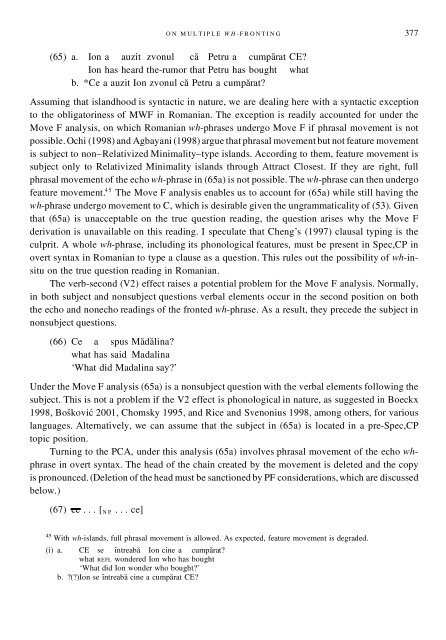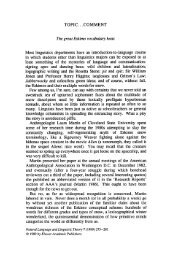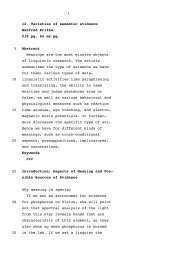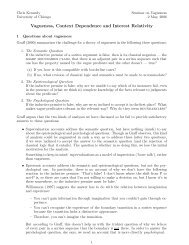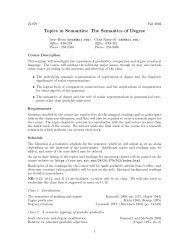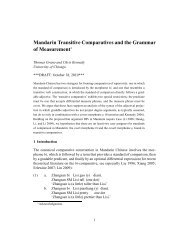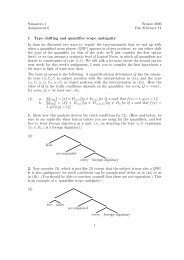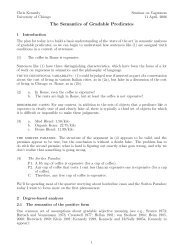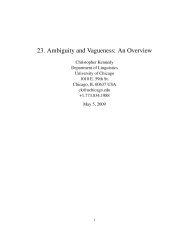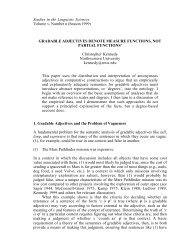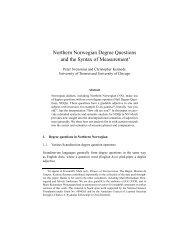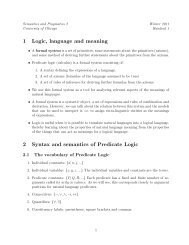376 ZÏ E L J K O B O SÏ K O V I Ć(64) a. *Il a lu quoi sans classer?(French)he has read what without to-file‘<strong>Wh</strong>at has he read without filing?’b. cf. Qu’a-t-il lu sans classer?c. *Kamu aturkan buku yang mana tanpa baca?(Malay)you filed book that which without reading‘<strong>Wh</strong>ich book did you file without reading?’d. cf. Buku yang mana kamu aturkan tanpa baca?This means that whatever analysis <strong>of</strong> (60) is adopted, it should not be applied to (64). Therefore,if the in-situ wh-phrases in (60) undergo feature movement, the in-situ wh-phrases in (64) cannotbe undergoing feature movement. 4 2 And if the in-situ wh-phrases in (60) undergo phrasal movementwith pronunciation <strong>of</strong> a lower copy, the same should not hold for the in-situ wh-phrases in(64). 4 3 Either way, we are dealing here with a distinct type <strong>of</strong> in-situ wh-phrase, different fromin-situ wh-phrases in non-MWF languages like English, Malay, and French. As a result, determiningthe most adequate analysis <strong>of</strong> (60) has important ramifications for analyzing in-situ wh-phrasesin non-MWF languages.2.3 A Syntactic Exception to the Obligatoriness <strong>of</strong> <strong>Wh</strong>-<strong>Fronting</strong> in MWF LanguagesComorovski (1996) notes that echo wh-phrases in Romanian can exceptionally stay in situ withinnon–Relativized Minimality islands (i.e., non-wh-islands). (65a) contrasts with (53) on the echoquestion reading. Notice that overt wh-movement out <strong>of</strong> the island is not allowed regardless <strong>of</strong>the reading. 4 442 The Move F analysis <strong>of</strong> (60) is thus inconsistent with my (1998a, 2000) analysis <strong>of</strong> French wh-in-situ constructions,which I argue involve feature movement on the basis <strong>of</strong> their locality restrictions. (Incidentally, at least some <strong>of</strong> theselocality restrictions do not hold in the Romanian constructions in question. Compare, for example, (59a) with my observationthat French disallows long-distance in-situ questions.) Thus, to the extent that it is successful, my (1998a, 2000)analysis favors the PCA treatment <strong>of</strong> (60) over the Move F treatment. Needless to say, if the latter turns out to be correct,it would invalidate the Move F analysis <strong>of</strong> French wh-in-situ. Notice also that in BosÏ ković 2000 (see also Cheng andRooryck 2000), I provide evidence that French wh-in-situ and wh-in-situ in traditional wh-in-situ languages like Chineseand Japanese should not be analyzed in the same way.43 The PCA is thus inconsistent with analyzing wh-in-situ in French and Malay as involving phrasal movement <strong>of</strong>the in-situ wh-phrase that takes place prior to Spell-Out, with subsequent pronunciation <strong>of</strong> a lower copy. (For analysesalong these lines for wh-in-situ languages where the PG test cannot be carried out (see footnote 41), see Groat and O’Neil1996:131 and Bobaljik 1995:360.Pesetsky (2000) suggests this analysis for Chinese, and a Move F analysis for Japanese.)44 I again focus on the dialect in which echo wh-phrases must move, where (i) contrasts with (65a).(i) *Ion crede caÆ Petru a cumpaÆ rat CE?Ion believes that Petru has bought whatRecall also that, as discussed above, there is more than one possible landing site for echo wh-phrases. For example, theecho wh-phrase in (i) can either stay within the embedded clause or move to the matrix clause, as illustrated in (ii). (Ionin (iia) can be a topic located outside CP.)(ii) a. Ion CE crede caÆ Petru a cumpaÆ rat?b. Ion crede caÆ CE a cumpaÆ rat Petru?I assume that the same options are in principle available for the echo wh-phrase in (65a). As will become clear duringthe discussion below, only the derivation on which the echo wh-phrase moves syntactically into the matrix clause canyield (65a), where the echo wh-phrase is pronounced in situ.
O N M U L T I P L E W H - F R O N T I N G 377(65) a. Ion a auzit zvonul caÆ Petru a cumpaÆ rat CE?Ion has heard the-rumor that Petru has bought whatb. *Ce a auzit Ion zvonul caÆ Petru a cumpaÆ rat?Assuming that islandhood is syntactic in nature, we are dealing here with a syntactic exceptionto the obligatoriness <strong>of</strong> MWF in Romanian. The exception is readily accounted for under theMove F analysis, on which Romanian wh-phrases undergo Move F if phrasal movement is notpossible. Ochi (1998) and Agbayani (1998) argue that phrasal movement but not feature movementis subject to non–Relativized Minimality–type islands. According to them, feature movement issubject only to Relativized Minimality islands through Attract Closest. If they are right, fullphrasal movement <strong>of</strong> the echo wh-phrase in (65a) is not possible. The wh-phrase can then underg<strong>of</strong>eature movement. 4 5 The Move F analysis enables us to account for (65a) while still having thewh-phrase undergo movement to C, which is desirable given the ungrammaticality <strong>of</strong> (53). Giventhat (65a) is unacceptable on the true question reading, the question arises why the Move Fderivation is unavailable on this reading. I speculate that Cheng’s (1997) clausal typing is theculprit. A whole wh-phrase, including its phonological features, must be present in Spec,CP inovert syntax in Romanian to type a clause as a question. This rules out the possibility <strong>of</strong> wh-insituon the true question reading in Romanian.The verb-second (V2) effect raises a potential problem for the Move F analysis. Normally,in both subject and nonsubject questions verbal elements occur in the second position on boththe echo and nonecho readings <strong>of</strong> the fronted wh-phrase. As a result, they precede the subject innonsubject questions.(66) Ce a spus MaÆ daÆ lina?what has said Madalina‘<strong>Wh</strong>at did Madalina say?’Under the Move F analysis (65a) is a nonsubject question with the verbal elements following thesubject. This is not a problem if the V2 effect is phonological in nature, as suggested in Boeckx1998, BosÏ ković 2001, Chomsky 1995, and Rice and Svenonius 1998, among others, for variouslanguages. Alternatively, we can assume that the subject in (65a) is located in a pre-Spec,CPtopic position.Turning to the PCA, under this analysis (65a) involves phrasal movement <strong>of</strong> the echo whphrasein overt syntax. The head <strong>of</strong> the chain created by the movement is deleted and the copyis pronounced. (Deletion <strong>of</strong> the head must be sanctioned by PF considerations,which are discussedbelow.)(67) ce . . . [ N P . . . ce]45 With wh-islands, full phrasal movement is allowed. As expected, feature movement is degraded.(i) a. CE se õˆntreabaÆ Ion cine a cumpaÆ rat?what REFL wondered Ion who has bought‘<strong>Wh</strong>at did Ion wonder who bought?’b. ?(?)Ion se õˆntreabaÆ cine a cumpaÆ rat CE?


